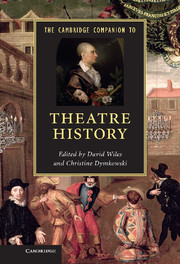14 - Circus
from Part IV - What?
Published online by Cambridge University Press: 05 February 2013
Summary
The circus might not at first glance appear to have much to do with either theatre or history. It mainly shows actual physical feats, not theatrical make-believe, story-telling or play-acting. It seems to inhabit a time of its own, separate from the course of events, ever the stuff of family outings and childhood nostalgia. Hasn’t the circus always been there? Even in the wake of the animal-free New Circus movement of the 1990s, and the advent of stylishly choreographed and expensive metropolitan shows such as the Montreal-based Cirque du Soleil, the great majority of the world’s circuses still peddle candy-floss and clowns, parping horns and miniature bikes, and sometimes sorry menageries. Nell Stroud, writer, performer and director of the successful neo-Edwardian-style Gifford’s Circus in England (see Fig. 19), has authored a children’s book on circus history, but assures me that, for the most part, circus people are not very interested in the subject. An honours degree in Circus Studies has for some years now been offered by Circus Space in London, but students receive only one lecture on circus history, with the theoretical emphasis firmly on the critical analysis of performance. By contrast, in art schools, the history of art and design has long been a mainstay of the classroom and indeed serves as the benchmark for progress and modernisation in these fields. It is my view that most circuses fail to engage in a conscious dialogue with their own past and so risk becoming slaves to a dwindling repertoire of hackneyed traditions. Attempting to rectify this situation, the journalist Tony Montague is, at the time of writing, currently working on a production for another Canadian company that draws upon key episodes of early circus in North America, but feels that this is quite a solitary and pioneering task.
- Type
- Chapter
- Information
- The Cambridge Companion to Theatre History , pp. 210 - 226Publisher: Cambridge University PressPrint publication year: 2012
References
- 1
- Cited by

